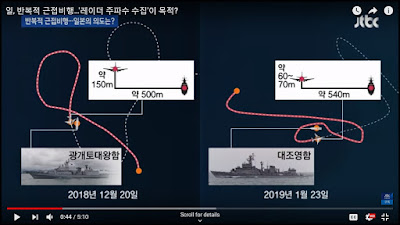A Bear bomber, an old Tu-95, approached Alaska on Sep. 12. Blackjack, Tu-160, bombers approached UK airspace twice during a period from September to October, 2018, in response to large NATO exercises in Europe. A section of Blackjack strategic bombers visited Venezuela on Dec 10. Su 24 Fencers flew near Japan on Jan 16, and the last is the Blackjack pair approaching Canada on the 26th of Jan. The title for Shin's program was Russia attack aircraft diplomacy- Putin pulls together disorderly countries. They would be China, Venezuela, Cuba, North Korea, Syria and Iran, in Shin's view.
In a relatively recent program, Channel A News Top Ten, reported the movement of a squadron of Backfire, Tu-22M, bombers to a base in the Vladivostock area. These aircraft were said to be upgraded with the capability to carry new long range air to surface missiles which would increase the threat they pose, especially to naval forces.
(Source- Channel A News Top Ten 1.28)
This Channel A Top Ten News graphic shows the airbases marked in orange which participated in the winter military exercises of the North Korean armed forces. The yellow area is the estimated area for tactical ballistic missile bases. Just south of that region is the Hwangju air base where Mig 23s are deployed. Furthest south and closest to the DMZ is a helicopter base in Heju. Further east and closest to the maritime peace zone negotiated between the DPRK and South Korea on the West Sea coast, are two Mig 19 bases, Gwa Il (north), and Tetan (south). The Blue marker designates the Sakganmol missile base in the news not too long ago.
The Mig 23s carried out unusual nighttime operations in December, considered risky and expensive for the North. The Top Ten analysts speculated concerning why the North would operate aircraft at night which is "unprecedented" for them. They also remarked on the precious fuel situation in the north due to sanctions.
The Mig bases are considered a threat to the Northwest islands inside the maritime peace zone. The aircraft are antiquated daylight combat aircraft. The South Korean Joint Chiefs said the military operations of the aircraft in the winter exercises did not violate the military agreements between the two Korean states (establishing no fly zones near the MDL/DMZ). The Top Ten program suggested that the movements in the North were perhaps a response to South Korean military exercises, and possibly the South Korean F-35 acquistion program.
(Source- Aircraftspots on twitter 1.28)
https://twitter.com/aircraftspots?lang=en
A B52 flight was reported by aircraft spots on twitter January 28. Shin In Kyun hasn't reported this yet. Aircraft spots had another movement within the past several days at Yokota, Japan, on January 26, a C-32 aircraft that Shin reported on January 29's Defense Daily program. Shin also reported a pattern of heavy lift aircraft traffic at Yokota, which he suggested indicated training readiness for civilian evacuations. He said the traffic was associated with preparations for the second summit, "Plan A," which if unsuccessful, ostensibly, could eventuate in implementation of Plan B. One wonders where he gets the Yokota information.
(Source- Shin In Kyun Defense Daily 01.29) Chart depicts recent Yokota air base activity of interest, during the period January 22-28 (left column), type aircraft (second column from left) and flight origin (third column), flight origin for heavy lift aircraft, C5, and C17s, are US bases, collected and published by Shin In Kyun.
The CV 22 training was evidence of decapitation mission preparation according to Shin. At the end he tries to characterize Plan B, as the military option lending greater weight to the invitation to negotiate in advance of a planned US-DPRK summit meeting.
(Source- Shin In Kyun Defense Daily 01.29)
The left depicts the C-32 which allegedly moves a special command aircraft for use in emergency or contingency situations to evacuate civilians according to Shin In Kyun; the middle represents the CV-22 Osprey night flying exercises, and the picture on the right reflects preparations of Japanese Self Defense Forces to do what exactly? The graphic says prepare practical use of Japanese assets. So on the one hand in red, no less, Trump's finger indicates negotiations and the other hand, in blue, indicates decapitation, a term President Moon of South Korea, has ordered his Defense Ministry to no longer use.
Update: Shin In Kyun appeared on the Channel A News Top Ten program on January 30 and covered the number 8 story on the C-32 arrival at Yokota. Osprey activities there were also reported. There was no mention of the B-52 report from aircraftspots on twitter. Nor were the activities of any large military airlift aircraft at Yokota reported. The latest issue of The Diplomat confirms the aircraftspots report:
The two bombers departed from Guam for their mission over East China Sea on January 28 and were refueled mid-air by a Boeing KC-135 Stratotanker.
https://thediplomat.com/2019/01/us-air-force-flies-2-b-52h-bombers-over-east-china-sea/
Shin uploaded a Daily Defense podcast to youtube dated Jan. 30, with his analysis of the B-52 flight.











